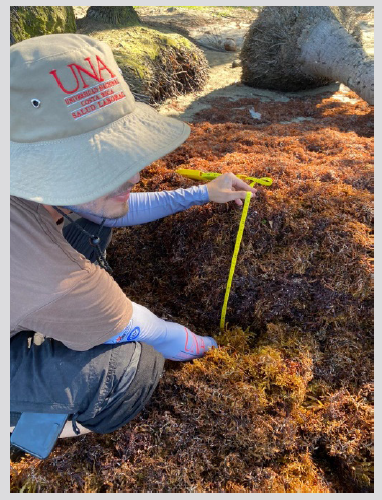Massive arrival of sargassum (Sargassum natans) into Costa Rica’s South Caribbean shore during 2022.
DOI:
https://doi.org/10.25268/bimc.invemar.2023.52.2.1222Keywords:
climate change, tourism, artisanal fishing, cahuita, eutrophicationAbstract
At the beginning of March 2022, there was a massive arrival event of sargassum (Sargassum natans) at different beaches in the South Caribbean of Costa Rica. Although the presence of this brown algae is not rare on the Caribbean coast of the country, the magnitude of the accumulated material is unusual. Puerto Viejo was the most affected area, accumulating up to 676.34 m3 of material in 100m of beach. The sargassum especially affected artisanal fishermen who had difficulty taking their boats to the sea and tour operators who saw the aesthetics of the beaches affected. The massive arrival of sargassum in the Greater Caribbean is already affecting the ways of life of different countries. In Costa Rica, it is a recent event that has the potential to affect the Caribbean coast environmentally and socio-economically. The articulation of institutions and civil society is necessary for monitoring and provide early warnings of future events.
References
Cortés, J. and I.S. Wehrtmann. 2009. Diversity of Marine Habitats of the Caribbean and Pacific of Costa Rica. 1-45. En: I. S. Wehrtmann, I.S and J. Cortés (Eds.). Marine Biodiversity of Costa Rica, Central America. Springer, Berlín.
Cortés, J., Fonseca, A. C., Nivia-Ruiz, J. and V. Nielsen-Muñoz. 2010. Monitoring coral reefs, seagrasses and mangrooves in Costa Rica (CARICOMP). Rev. Biol. Trop., 58(3):1-22.
Desrochers, A., S-A. Cox, H.A. Oxenford and B. van Tussenbroek. 2020. Sargassum uses guide: a resource for Caribbean researchers, entrepreneurs and policy makers. Informe final. Food and Agriculture Organization (FAO). Bridgetown. 172 p.
Fonseca, A. C. 2003. A rapid assessment at Cahuita National Park, Costa Rica. Atoll Res. Bull., 496: 248-257. doi.org/10.5479/si.00775630.496-14.258
Gower, Jim., Young, E., and S. King. 2013. Satellite images suggest a new Sargassum source region in 2011. Remote Sens Lett, 4 (8): 764-773. doi.org/10.1080/2150704X.2013.796433
Guiry, M.D. and Guiry, G.M. 2015. Algae Base Version 4.2. World-Wide Electronic Publication, National University of Ireland, Galway.
Hu, C., Murch, B. Barnes, B.B., Wang, M., Maréchal, J.P., Franks, J., Johnson, D., Lapointe, B.E., Goodwin, D., Schell, J. and A. Siuda. 2016. Sargassum watch warns of incoming seaweed. Eos, 97: 10-15. doi.org/10.1029/2016EO058355
NOAA. 2021. What is the sargasso sea? National Ocean Service website. https://oceanservice.noaa.gov/facts/sargassosea.html. 1/04/21
Resiere,D., Valentino,R., Nevière,R., Banydeen,R., Gueye,P., Florentin, J., Cabié,A., Lebrun, T., Mégarbane, B., Guerrier,G. & H. Mehdaoui. 2018. Sargassum seaweed on Caribbean islands: an international public health concern. The Lancet, 392: 2691.
Schell J, Goodwin D, Siuda A. 2015. Recent Sargassum Inundation Events in the Caribbean: Shipboard Observations Reveal Dominance of a Previously Rare Form. Oceanography, 28:8–10. doi: 10.5670/oceanog.2015.70.
Secretaría de Medio Ambiente y Recursos Naturales (SEMARNAT). 2021. Lineamientos Técnicos y de Gestión para la Atención de la Contingencia Ocasionada por Sargazo en el Caribe Mexicano y el Golfo de México. Gobierno de México. Ciudad de México. 41p.
Smetacek, V. and A.Zingone. 2013.Green and golden seaweed tides on the rise. Nature, 504:84–88. doi.org/10.1038/nature1286
Trinanes, J., Putman, N.F., Goni, G., Hu, C. & M. Wang. 2021. Monitoring pelagic Sargassum inundation potential for coastal communities. Journal of Operational Oceanography: 1-12. doi.org/10.1080/1755876X.2021.1902682.
van Tussenbroek, B., Hernandez-Arana, H., Rodríguez-Martínez, R., Espinoza-Avalos, J., Canizales-Flores, H., González-Godoy, C. & Collado-Vides, L. 2017. Sever impact of brown tides caused by Sargassum spp. on near shore Caribbean seagrass communities. Mar Pollut Bull, 122: 272-281. doi.org/10.1016/j.marpolbul.2017.06.057.

Downloads
Published
How to Cite
Issue
Section
License
Copyright (c) 2023 Lilliana Piedra-Castro, M.Sc. Marco Ramírez-Vargas

This work is licensed under a Creative Commons Attribution-NonCommercial-ShareAlike 4.0 International License.

